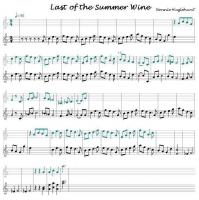-
Posts
182 -
Joined
-
Last visited
Everything posted by Nanette Hooker
-
The Etude looks like Regondi's Golden Exercise - it is found in Atlas book "Comtemplating the Concertina".
-
Hi My favourite English Concertina tutor is "Contemplating the Concertina" by Allan Atlas. I found that that it is advanced and I found it good to to learn all the notes. A few books are here http://www.buttonbox.com/learn-to-play-concertina.html For the beginner I find that Frank Butler is very good, but now I find it too easy. It is available here http://www.concertina.com/butler/butler-the-concertina-tutor.pdf I also like the book "New Method for the Concertina" by Giulio Regondi.
-

Wakker Parnassus on Youtube
Nanette Hooker replied to wim wakker's topic in General Concertina Discussion
Enjoyed the video of the classical music on the English concertina. Well done Wim. -
-
Here is my band's version of Moscow Nights. I play a Lachenal Baritone. My band is called the Lettuce Dance Band. Moscow Nights
-
John Nixon has recorded 1st Gymnopedie on the CD "The English Connection". It is played on three concertinas - treble, baritone and double bass. Sounds great.
-
Found this news by accident while looking for something else: "Professor Allan Atlas will present a Lecture/Demonstration on Nineteenth-Century English Concertina on Friday, January 29, 2010, at 3:00 p.m. in Casadesus Recital Hall, Fine Arts Building at Binghamton University. This event is sponsored by the Binghamton University Music Department." Allan Atlas Lecture/Demonstration
-
There is a excellent arrangement of three 3/2 tunes by Simple Gifts. Simple Gifts webpage. They do Waters of Holland, Easter Thursday and Barham Downs on their CD "Other Places, Other Times" and you can buy a music book with the CD. Many of the tunes in the book is arranged for two to four instruments.
-
Frank Butler has written an arrangement of this piece. It is in his Concertina Mini Tunes booklet.
-
I have just recorded myself playing Leisure Moments No. 1. I have been learning it for a long time. I would be grateful for any comments from C.net forum members. Constructive criticism please. The piano part is a midi file. Leisure Moments.mp3
-

Getting over the hump?
Nanette Hooker replied to michael sam wild's topic in General Concertina Discussion
Sounds like you need pieces in the key of A major (F# c# and g# all use the third finger of the right hand). Some examples I've played from the ECD repertoire include: Long Odds, Lord How's Jig, The Bishop, The Dressed Ship, Elverton Grove, The First of April, Gathering Peascods, Geud Man of Ballangigh, Grimstock, Prince William, The Rakes of Rochester, Sun Assembly. I remember one gig where nearly the whole dance list was in A. There is variety in this list from the fairly straightforward to the finger twisters. You're right - tunes in A major are good (and any other tunes with 3 sharps or more). Thanks for this list. I have never heard of them - where can I get the sheet music? -

Getting over the hump?
Nanette Hooker replied to michael sam wild's topic in General Concertina Discussion
I have found three things which have helped me progress:- 1. Play regularly (once a week) with friends who are good musicians. 2. Play your instrument every day (minimum 5 minutes). 3. Play and practice exercises from a tutor book (I love playing exercises - my obsession) After I had a stroke (4.5 years ago) I had to do a lot of physio exercises (which were exceeding boring) but trained me to do regular exercises. I have used my concertina to help me develop my motor skills and strengthen the muscles in my right hand. Can anyone suggestion a piece of music to strengthen the third finger of right hand? I play EC. -
It is very exciting to find the English Concertina appearing in other cultures, and it is interesting to see it in a Bolivian band playing Bolivian songs. I followed the links from the video and found some other videos of the band called "Alapacha". They have a webpage which is in Spanish and using Google language thingy I found some details on the concertina player. Waldo Riveros Pablo Trujillo Place and date of birth La Paz-Bolivia, January 15, 1945 Occupation: Accountant General, Musician Self Instruments: 20 years of CONCERTINA - then there is a big list of recordings on LPs and CDs The videos I watched so far don't show the concertina player much, however, the band has 8 members and they have a singer.
-

what do you play that's not Irish/english?
Nanette Hooker replied to Robert Booth's topic in General Concertina Discussion
I mostly play Russian, Serbian, Bulgarian, Klezmer, Romanian, Macedonian, Greek, Israeli music. I also like to play TV and movie theme music e.g. Rumpole of the Bailey, Foyle's War and music written by Bach. -
My band is called "Lettuce Dance Band". We met at a dance group and started playing dance music for our parties. I suggested the name as a joke, but everyone else thought it was a great name. I have become rather fond of the name and now we dress in green. I have even brought ear rings that look like little lettuces.
-
I have scanned my copy of Regondi's tutor "New Method for the Concertina", and uploaded it to my webpage here I think this is a great book so I have made it available to anyone who wants it.
-

Interesting Book on British Music Hall
Nanette Hooker replied to Alan Day's topic in General Concertina Discussion
I didn't realised that Little Tich played the concertina. This isn't mentioned on Wikipedia, however it does say that he had five fingers and a thumb on each hand. This would be quite an asset when playing the concertina. -
Hi I downloaded the music from Ed's webpage, printed it off, typed out a contents list and made a book. Here is the contents list. David's list looks bigger
-
Do you have a link for that? Go to the British Pathe site here and do a search for "elliots"
-
Thanks for all your comments. I have watched Pauline de Snoo videos and have noticed that you need to hold the instrument away from the body a lot of the time. I have watched the video of the Seven Elliotts "Sea Shells Have Music" with Tommy Elliott playing the concertina and he plays standing while hold his instrument. He makes it look so easy. Also I have watched videos of Tomas Novotny (http://www.youtube.com/user/tnovotny1). From the above examples, I think the neck cord is not really necessary. I have also found that neck chord is very uncomfortable because it cuts into the back of the neck. A shirt with a collar needs to be worn - not suitable clothing in a tropical environment where I live because they are too hot. I have decided to play while sitting on a high stool and learn to play without sheet music (not sure I have the confidence to do this for a public performance) but I am making a concerted effort. My plan is to build up the strength in my right hand gradually by holding the instrument up off the knee for short periods at first, until my right hand gains more strength. I have also watched all of Goran's videos on YouTube. I like some of his ideas, I get the impression that he doesn't sell them, but does he suggest making your own straps?
-
I have just found a recording of Gregory Matusewitch on a album called "EUROPE Patchwork Europe - Early Recordings (1911-1954)". The tune is from Belarus and is called Yiddisher Wulach. The album states that he is playing a piccolo? You can hear a sample here
-
Recently I performed with my band and my friend (who plays Piano Accordion) stood for a couple of pieces of music. Someone took a photo (see here) and it made me realise that I need to play either without music OR stand. I have decide to try and stand and have tried using a neck cord that I purchased from Concertina Connection a few years ago. I am finding it rather difficult and a few buttons seem have moved slightly. I know I need to practice while standing. I would appreciate to hear from players who use neck cords. Where purchased? Difficulties, etc.?




